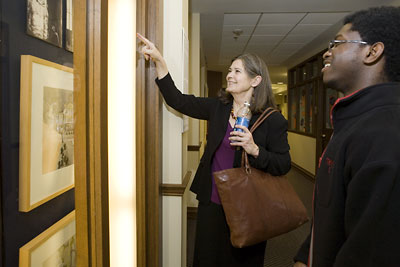Beautiful and damned, Zelda Fitzgerald sought refuge in art, says granddaughter at opening of exhibit
By George Lowery

Zelda Fitzgerald led a rich, tragic life, awash in art. At 25, inspired by the Ballets Russes, she embarked on years of serious dance training. She wrote a novel. She painted. She created elaborately costumed paper dolls. She was the inspiration for heroines in the novels of her husband, F. Scott Fitzgerald.
But it was through her art that her granddaughter got to know her. Eleanor Lanahan, daughter of the Fitzgeralds' only child, is a writer and illustrator. She spoke about her grandparents at the March 5 opening of an exhibition at the Carol Tatkon Center, "Zelda by Herself: The Art of Zelda Fitzgerald," which runs until March 29.
Lanahan was 2 months old when her grandmother died in a mental hospital fire in 1947. She grew up surrounded by Zelda's paintings and paper dolls. Lanahan first realized her grandparents were famous when Life magazine came to photograph Zelda's art. Years later, when Lanahan was selecting excerpts from Zelda's writings to illustrate a book on her art, "I realized that her art was really a fresh medium for telling a story."
Zelda, born in Montgomery, Ala., in 1900, "was clever, mischievous and popular. Her mother championed her sense of drama, but her father, Judge Anthony Sayre, tried to exert a more sobering influence," said Lanahan. Scott Fitzgerald -- who enlisted in the army just before flunking out of Princeton University, and convinced he would die in the First World War -- pursued and married Zelda over the objections of her parents: "They hoped she wouldn't marry a penniless, unpublished Yankee writer."
A week before their April 3, 1920, marriage in New York City's St. Patrick's Cathedral, Scott's "This Side of Paradise" was published to acclaim. He and Zelda were promoted in newspapers and magazines as glamorous, hard-partying emblems of the Jazz Age, "the greatest, gaudiest spree in history. Zelda played his highly quotable sidekick, the quintessential flapper," Lanahan said.
Zelda contributed to magazines, "though on the whole she seemed content to toss her talents aside and be a decorative wife," Lanahan said. "In spite of my grandparents' legendary antics -- from jumping into the fountain at the Plaza Hotel to riding on top of a taxi -- I've come to think of them as old souls and wise in some fundamental way. They never failed to express their love for each other, from their first romance to their inescapable separation."
Twenty years later, Zelda transmuted her wedding day into a hallucinatory gouache of St. Patrick's Cathedral. Said Lanahan, "The entire city seems to celebrate. A magnanimous hand showers theater tickets on the crowd as the wedding party emerges with an Easter parade."
In 1924 the peripatetic Fitzgeralds sailed for Europe. "I hate a room without an open suitcase. It seems so permanent," Zelda once said. Lanahan said her grandparents were "escaping Prohibition, the high cost of living and, they hoped, their own bad habits."
The doctor who coined the term "schizophrenic" diagnosed Zelda with the disease in 1930, and for the next 17 years until her death she was often hospitalized. But Zelda continued to paint seriously when her condition allowed, and her vivid abstract cityscapes and religious paintings were exhibited.
"I like to think her faith had finally brought her peace," Lanahan said. "I'm certain she'd be pleased that her paintings have come to light. ... it's plain to see why Scott called her a 'true original.'"
Media Contact
Get Cornell news delivered right to your inbox.
Subscribe